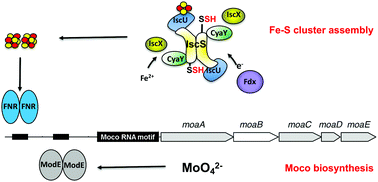The regulation of Moco biosynthesis and molybdoenzyme gene expression by molybdenum and iron in bacteria
Abstract
Bacterial molybdoenzymes are key enzymes involved in the global sulphur, nitrogen and carbon cycles. These enzymes require the insertion of the molybdenum cofactor (Moco) into their active sites and are able to catalyse a large range of redox-reactions. Escherichia coli harbours nineteen different molybdoenzymes that require a tight regulation of their synthesis according to substrate availability, oxygen availability and the cellular concentration of molybdenum and iron. The synthesis and assembly of active molybdoenzymes are regulated at the level of transcription of the structural genes and of translation in addition to the genes involved in Moco biosynthesis. The action of global transcriptional regulators like FNR, NarXL/QP, Fur and ArcA and their roles on the expression of these genes is described in detail. In this review we focus on what is known about the molybdenum- and iron-dependent regulation of molybdoenzyme and Moco biosynthesis genes in the model organism E. coli. The gene regulation in E. coli is compared to two other well studied model organisms Rhodobacter capsulatus and Shewanella oneidensis.



 Please wait while we load your content...
Please wait while we load your content...